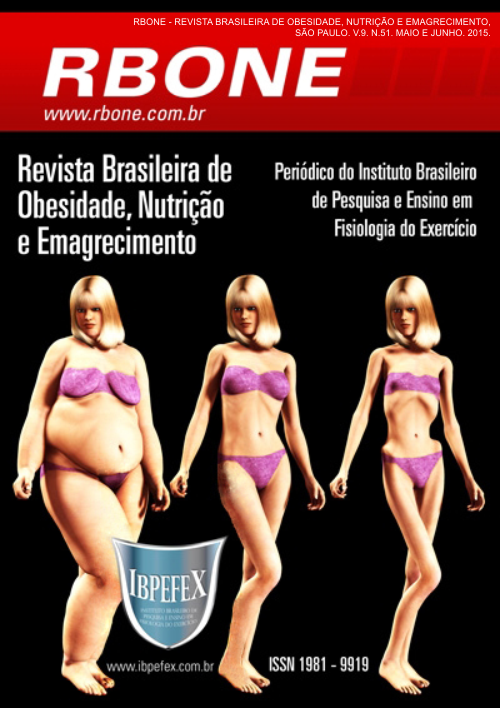Nutritional evolution of patients with AIDS treated in an nutritional clinic
Abstract
Introduction and Aim: Animproper diet affects health,quality of life and response to treatment of the patient. Thus, the studyaimed to evaluate the nutritional status of patients with AIDS out patients Nutrition. Materials and methods: A retrospective study using secondary data. Records of patients treated between 2005 and 2010 were analyzed. Evolution of nutritional status and the risk of developing metabolic complications of abdominal fat associated with waist circumference (WC) were analyzed in relation to age, sex, number of queries, and time of treatment, medication use, CD4 count, viral load and physical exercise on the first and last visit. Results, Discussion and Conclusion: Most patients (70 %) maintained their nutritional status and did not alter the risk related to CC. Most that have improved nutritional status, physical exercises practiced, had CD4 counts greater than 500 and detectable viral load. Patients who started treatment with worse nutritional and immune status with increased risk of subsequent immunological deterioration decreased the risk related to the CC. The results suggest that reducing the weight and CC may be associated with the degree of immune deterioration and viral load in these patients. The majority of patients followed kept the nutritional status, immune status and the degree of risk related to CC.
References
-Arruda Júnior, E.R.; e colaboradores. Perfil dos Pacientes com Hipertensão Arterial Incluídos em uma Coorte com HIV/AIDS em Pernambuco, Brasil. Arq Bras Cardiol. Vol. 95. Núm. 5. p. 640-647. 2010.
-Braga, L.A.; Silva, C.A.B. Avaliação nutricional e metabolismo de pacientes com HIV em uso de terapia antirretroviral no Nordeste do Brasil. Rev. Bras. em Promoção da Saúde. Vol. 23. Núm. 4. p. 368-373. 2010.
-Campos, A.; e colaboradores. Carga Viral Vaginal de HIV em mulheres brasileiras infectadas pelo HIV. Rev. Assoc. Med. Bras. Vol. 54. Núm. 1. p. 67-71. 2008.
-Colombrini, M.R.C.; Lopes, M.H.B.M.; Figueiredo, R.M. Adesão à terapia antirretroviral para HIV/AIDS. Rev Esc Enferm da USP. Vol. 40. Núm. 4. p. 576-81. 2006.
Cuppari, L. Guias de medicina ambulatorial e hospitalar. Nutrição clínica no adulto. Editora Manole. 2ª edição. 2005.
-Curti, M.L.R.; Almeida, L.B.; Jaime, P.C. Evolução de parâmetros antropométricos em portadores do vírus da Imunodeficiência Humana ou com Síndrome da Imunodeficiência Adquirida: um estudo prospectivo. Rev. de Nutr. Vol. 23. Núm. 1. p. 57-64. 2010.
-Diehlla Dias, J.R.; e colaboradores. Prevalência da Lipodistrofia associada ao HIV em Pacientes Ambulatoriais Brasileiros: Relação com Síndrome Metabólica e Fatores de Risco Cardiovascular Arq Bras Endrocrinol Metab. Vol. 52. Núm. 4. 2008.
-Eidam, C.L.; Lopes, A.S.; Guimarães, M.D.C.; Oliveira, O.V. Estilo de vida de pacientes infectados pelo vírus da imunodeficiência adquirida (HIV) e sua associação com a contagem de linfócitos T CD4+. Rev. Bras. Cineantropom. Desempenho Hum. Vol. 8. Núm. 3. p. 51-57. 2006.
-Koehnlein, E.A.; Salado, G.A.; Yamada, A.N. Adesão à reeducação alimentar para perda de peso: determinantes, resultados e a percepção do paciente. Rev. Bras. Nutr. Clin. Vol. 23. Sup. 1. p. 56-65. 2008.
-Ministério da Saúde. Boletim Epidemiológico AIDS 2013. Disponível em: <http://www.aids.gov.br/publicacao/boletim-epidemiologico-2010>.Acessado dia 25/02/2014.
-Ministério da Saúde. Portal da Saúde. AIDS. Disponível em: <http://www.aids.gov.br/pagina/aids-no-brasil>.Acessadodia 5/03/2014.
-Ministério da Saúde. Portal sobre AIDS, Doenças Sexualmente Transmissíveis e Hepatites Virais -Aprenda sobre HIV e AIDS. Disponível em: <http://www.aids.gov.br/data/Pages/LUMISBF548766PTBRIE.htm>. Acessado em 26/02/2014.
-Ministérioda Saúde. Saúde Feminina. 2009. Acessado em 01/03/2014. Disponível em: <http://portal.saude.gov.br/portal/arquivos/pdf/23_07_saude_feminina.pdf>
-Oliveira, O.M.V.; Medeiros, R.S.; Nascimento, M.A.B.; DebonI, M.S. Perfil nutricional e fatores de risco para obesidade central de pessoas que vivem com HIV/AIDS. Com. Ciências da Saúde. Vol. 19. Núm. 4. p. 305-314. 2008.
-Porto, M.C.V.; Brito, I.C.; Calfa, A.D.F.; Amoras, M.; Villela, N.B.; Araújo, L.M.B. Perfil do obeso classe III do ambulatório de obesidade de um hospital universitário de Salvador, Bahia. Arq. Bras. Endocrinol. Metab. Vol. 46. Núm. 6. p. 668-673. 2002.
-Rocha, P.B.; Schuch, I. Perfil alimentar e nutricional dos pacientes HIV positivo atendidos em um serviço público de saúde de PortoAlegre-RS. Nutrire: Rev. Soc. Bras. Alim. Nutr. Vol. 34. Núm. 3. p. 1-15. 2009.
-Roitt, I.N.; Delves, P.J. Fundamentos de Imunologia. Rio de Janeiro. Panamericana. 2004.
-Seidl, E.M.F.; Rossi, W.S.; Viana, K.F.; Meneses, A.K.F.; Meireles, E. Crianças e adolescentes convivendo com HIV/AIDS e suas famílias: aspectos psicossociais e enfrentamento. Pisc: Teor e Pesq. Vol. 21. Núm. 3. p. 279-88. 2005.
-Silva, M.C.A.; Burgos, M.G.P.A.; Silva, R.A. Alterações nutricionais em pacientes com AIDS em uso de terapia antirretroviral. J Bras Doenças Sex Transm. Vol. 22. Núm.3. p. 118-122. 2010.
-Silva, E.F.R.; Lewi, D.S.; Vedovato, G.M.; Garcia, V.R.S.; Tenore, S.B.; Bassichett, K.C. Estado nutricional, clínico e padrão alimentar AIDS. Rev. Bras. Epidemiol. Vol. 13. Núm. 4. p. 677-88. 2010.
-Souza, J.L.; e colaboradores. Prevalência de obesidade e fatores de risco cardiovascular em Campos, Rio de Janeiro. Arq Bras de Endocrinol. e Metab. Vol. 47. Núm. 6. p. 669-676. 2003.
Authors who publish in this journal agree to the following terms:
- Authors retain the copyright and grant the journal the right of first publication, with work simultaneously licensed under the Creative Commons Attribution License BY-NC which allows the sharing of the work with acknowledgment of the authorship of the work and initial publication in this journal.
- Authors are authorized to enter into additional contracts separately for non-exclusive distribution of the version of the work published in this journal (eg, publishing in institutional repository or book chapter), with acknowledgment of authorship and initial publication in this journal.
- Authors are allowed and encouraged to post and distribute their work online (eg, in institutional repositories or on their personal page) at any point before or during the editorial process, as this can bring about productive change as well as increase impact and impact. citation of published work (See The Effect of Free Access).






